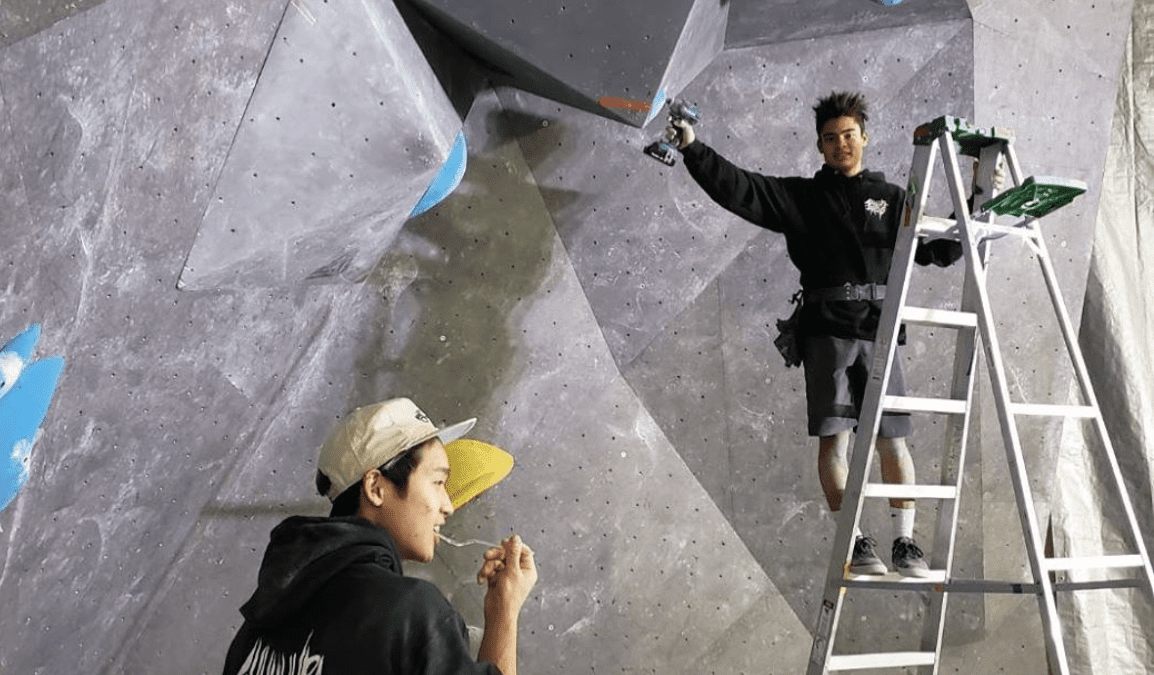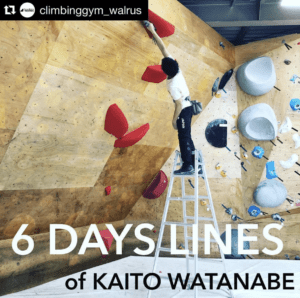Routesetting in Japan with Kaito Watanabe
A brief look into Japan's routesetting, climbing, and community.

In many ways, climbing refuses definition. Though it was once primarily described by its natural beauty, the advent of indoor climbing has greatly changed what it means to be a climber.

Brief History of Routesetting:
Indoor Climbing was invented to train climbers to become stronger for their outdoor projects. The process of putting little wooden grips on a sixty-degree board began out of necessity. Though the first climbing competition was held in 1985, it was on real rock. This exceptional concept was cool, but damaging to the environment and not sustainable for a long period of time. In 1986, France hosted the first artificial wall climbing competition and so began competition routesetting.
Since 1986, a lot has changed. The days of heinous crimps are over, and volume climbing has really come into its own. Though routesetting is an ever changing beast, it maintains consistencies all across the globe. There are certain practices that travel from country to country just as there are practices that remain unique to geographic areas.
A person need not look further than the United States to notice that routesetting changes depending on where you are. By comparison to the setting in Europe, American setting is considered powerful. If we can accept that setting styles vary geographically, then it becomes pretty sick to look at each geographic region.
Japan is one such region. The island nation is known for their tough sequences and brutal strength when it comes to the climbing. So what defines Japan’s routesetting?
Routesetting in Japan:
Japan’s Kaito Watanabe believes it’s the culture. Watanabe is a 23-year-old rock climber, competition climber, and routesetter. Over the last nine months, Watanabe has been setting and competing in North America. He has been setting for over five years and has goals of being an IFSC routesetter
Watanabe used to set a gym in Tokyo called “Underground”. The average Canadian might walk into such a facility and recognize a bunch of the hold sets. A few hold-sets aside, Underground features a bunch of classic shapes from companies like Blue Pill and Cheeta. If you take a closer look, however, things begin to look differently.
The first thing you will notice is the hold density. Even though the facility features some of the newest fibreglass on the market, the gym is designed to support as many boulder problems as will fit on the walls. These problems include older and newer holds to vary the type of climbing the patron is exposed to.
The setting itself is hard, if you watch Louis Parkinson explore Japan’s gyms, it is pretty easy to notice how difficult he finds the setting. So what is it that makes it so hard? Watanabe says, “I feel like Japanese bouldering is usually high complexity, even easy boulders. Flexibility is also much more important and there are a lot of small box moves.”
Highly flexible climbing and small box moves ensure that the climber must offer a level of athleticism to climb the harder problems. The small-box moves of the Japanese circuit is indicative a shorter, more powerful style of climbing the pressures the climber’s grip strength as well as their bicep strength.
This type of setting style can be frustrating for many new climbers that are expecting to be good at climbing quickly. Grip and finger strengths are difficult to improve. Where climbers in the West might be frustrated that the setting isn’t designed for easy sending, Eastern climbers become more motivated. Watanabe says, “I think in Japan people see it more that they are not good enough yet and they need to get better.”
Japan’s Climbing Community:
However, Watanabe points more to the community than the setting as the source of Japan’s strength. Watanabe said, “I think it is not just the setting, but mainly that we always climb a lot together and are always sharing ideas.” This communal approach to climbing ensures that every climber has a large number of people they feel like they can talk to for help with beta. Watanabe goes on to say, “Setting culture is not very different”, between Canada and Japan, lending further evidence to the thought that it is Japan’s community that makes it strong.
Furthering this idea, Watanabe says, “We have a lot of people in Japan, so the population density helps create strong climbers. There are also many gyms in Japan so people move around more between them.”
Climbing at many gyms grants the individual access to a variety of boulder problems, styles, and angles. As each new boulder problem a climber completes makes them stronger, climbing on a variety of different styles in a place like Tokyo can only aid the developing athlete. This style of “gym sharing” as it is called in North America, also creates intersections between various gym communities. Where a North American climber might describe themselves by their gym, Japan’s climbers are not limited by their walls. Instead they are able to identify as climbers a part of Japan’s greater climbing community.


